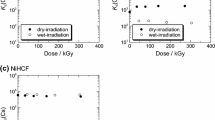Conclusions
-
1.
On Cr2O3 containing Cr2+ ions, C2-C6 paraffin hydrocarbons are adsorbed rapidly and reversibly at temperatures below 100°. The heats of adsorption at low degrees of surface coverage are 1.5–2 times as great as the heat of nonspecific physical adsorption of paraffins on other oxides. As the surface of Cr2O3 is covered, the heat of adsorption decreases.
-
2.
At temperatures above 100° on the investigated sample of Cr2O3, against a background of equilibrium adsorption, there is an activated irreversible chemisorption.
-
3.
Equilibrium adsorption of paraffins with increased heats and irreversible chemisorption occur on Cr2+ions.
-
4.
It was hypothesized that the increase in the adsorption of n-C6H14 after γ irradiation of Gr2O3is associated with the formation of supplementary amounts of Cr2+ions after the capture of electrons by Cr3+ ions.
Similar content being viewed by others
Literature cited
J. Howard and H. S. Taylor, J. Amer. Chem. Soc.,56, 2259 (1934).
V. L. Keibal, A. V. Kiselev, I. M. Savinov, V. L. Khudyakov, K. D. Shcherbakova, and Ya. I. Yashin, Zh. Fiz. Khim.,41, 2234 (1967).
B. Trepnell, Chemisorption [Russian translation], IL (1958), p. 99.
F. Stone, Catalysis. New Physical Methods of Investigation [Russian translation], Mir (1964), p. 309.
R. Chaplin, P. Chapman, and R. H. Griffith, Proc. Roy. Soc.,A224, 412 (1954).
A. M. Rubinshtein, K. I. Slovetskaya, and T. R. Brueva, in: Methods of Investigation of Catalysts and Catalytic Reactions [in Russian], Vol. 1, Izd-vo SO AN SSSR, Novosibirsk (1965), p. 276.
K. I. Slovetskaya and A. M. Rubinshtein, Kinetika i Kataliz,8, 1115 (1968).
K. I. Slovetskaya and A. M. Rubinshtein, Izv. Akad. Nauk SSSR, Ser. Khim., 1887 (1971).
K. I. Slovetskaya and A. M. Rubinshtein, Kinetika i Kataliz,7, 342 (1966).
K. I. Slovetskaya, T. R. Brueva, and A. M. Rubinshtein, Kinetika i Kataliz,7, 566 (1966).
A. M. Rubinshtein, K. I. Slovetskaya, and T. R. Brueva, Izv. Akad. Nauk SSSR, Ser. Khim., 900 (1965).
E. Koberstein, Z. Elektrochem.,64, 906 (1960).
S. A. Greene and H. Pust, J. Phys. Chem.,62, 55 (1958).
E. Cremer and H. Huber, Angew. Chem.,73, 461 (1961).
I. I. Van Rejen, W. M. H. Sachtler, P. Cossee, and D. H. Brower, Proc. 3rd Inter. Congress of Catalysis, Vol. 2, Amsterdam (1965), p. 829.
A. V. Kiselev, Zh. Fiz. Khim.,38, 2753 (1964).
Author information
Authors and Affiliations
Additional information
Translated from Izvestiya Akademii Nauk SSSR, Seriya Khimicheskaya, No. 9, pp. 1969–1975, September, 1972.
Rights and permissions
About this article
Cite this article
Slovetskaya, K.I., Aiginin, F.N. & Rubinshtein, A.M. Adsorption of paraffin hydrocarbons on nonirradiated and γ-irradiated chromium oxide. Russ Chem Bull 21, 1911–1916 (1972). https://doi.org/10.1007/BF00854604
Received:
Issue Date:
DOI: https://doi.org/10.1007/BF00854604



